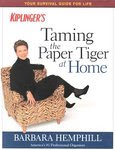 Blogger's Note: This post was originally published in January of 2010 and was updated in January of 2016.
Blogger's Note: This post was originally published in January of 2010 and was updated in January of 2016. One of the perks of offering organizing services is that I have an excuse to read--and own--lots of organizing books, each with its own unique perspective and strengths. Today, I'll share one nugget of wisdom from each of five organizing books. (I plan to share additional books in the future, so stay tuned!) These nuggets aren't intended to summarize the books or even to offer the author's main message; they're just helpful tidbits. Links are Amazon Affiliate links, but these books may also be found in your local library!
 Conquering Chronic Disorganization, by Judith Kohlberg
Conquering Chronic Disorganization, by Judith KohlbergMs. Kohlberg shares a fascinating concept that she calls "kinetic sympathy". Here's the idea: if you touch something, you are less likely to discard it than if someone else holds the item when you are deciding what to purge. Take home message: enlist the help of a buddy when it's time to declutter!
 Taming the Paper Tiger At Home, by Barbara Hemphill
Taming the Paper Tiger At Home, by Barbara HemphillMs. Hemphill explains the distinction between action files and reference files. Action files hold papers that require a specific action on your part (a phone call to make, a bill to pay), while reference files contain papers that don't require further action now but may be useful in the future (your medical records, bank statements, etc.) Filing actionable papers keeps them from piling up!
 Organizing from The Inside Out, by Julie Morgenstern
Organizing from The Inside Out, by Julie MorgensternI already referenced "S.P.A.C.E." in my last post. Another helpful concept is what Ms. Morgenstern calls "the kindergarten model of organization" in which you create "zones" or "stations" for different activities. For example, rather than storing your flour and sugar in your pantry with the pasta and canned beans, you can create a baking "station" in your kitchen where you store mixing bowls, measuring cups, measuring spoons, a rolling pin, flour, sugar, baking soda, etc.
 Totally Organized, by Bonnie McCullough
Totally Organized, by Bonnie McCulloughThe fastest way to improve the appearance of a room is to work from the largest item in the room to the smallest when tidying. This means that you make the bed in the bedroom, clear the table in the kitchen and dining room, and straighten cushions on the sofa in the living room and family room. This is a simple concept, but one that might not come naturally for everyone.
 It's All Too Much, by Peter Walsh
It's All Too Much, by Peter WalshRather than starting with the "stuff" and determining what to keep and how to organize it, start by imagining the life that you want to live, and work backwards from there. A refreshing approach when you're really stuck!
Photo Credit for top photo: Stock X Change
